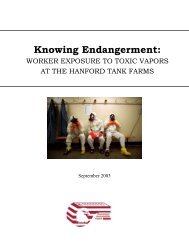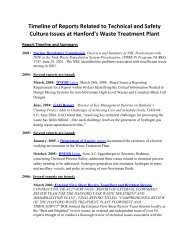Reducing the Risks of High-Level Radioactive Wastes at Hanford
Reducing the Risks of High-Level Radioactive Wastes at Hanford
Reducing the Risks of High-Level Radioactive Wastes at Hanford
You also want an ePaper? Increase the reach of your titles
YUMPU automatically turns print PDFs into web optimized ePapers that Google loves.
72 Alvarez<br />
melter vessel, allowing molten glass to leak/drop out <strong>of</strong> <strong>the</strong> melter, uncontrolled<br />
<strong>of</strong>f gas from <strong>the</strong> melter, failure <strong>of</strong> <strong>the</strong> joule-he<strong>at</strong>ing system, and plugging <strong>of</strong> <strong>the</strong><br />
glass pour drain.” 157<br />
The <strong>Hanford</strong> vitrific<strong>at</strong>ion plant will have <strong>the</strong> largest melters in <strong>the</strong> world—<br />
two for high-level wastes and <strong>the</strong> o<strong>the</strong>r for low-activity wastes. Initially <strong>the</strong><br />
TWRS program was to begin with a rel<strong>at</strong>ively small, pilot plant th<strong>at</strong> would<br />
process between 6 to 13 percent <strong>of</strong> <strong>Hanford</strong>’s tank waste. This would have<br />
allowed verific<strong>at</strong>ion <strong>of</strong> design and technical approaches with minimal economic,<br />
programm<strong>at</strong>ic, and safety risk.<br />
For instance, according to NRC-sponsored research <strong>the</strong> use <strong>of</strong> surrog<strong>at</strong>e<br />
wastes, as is <strong>the</strong> case with current <strong>Hanford</strong> melter tests, may prove inadequ<strong>at</strong>e<br />
because “actual <strong>Hanford</strong> wastes may be more reactive.” 158 But <strong>the</strong> pilot plant<br />
was scrapped, despite recommend<strong>at</strong>ions by <strong>the</strong> NAS, NRC, GAO and DOE’s<br />
construction contractor. 159 Instead <strong>the</strong> Energy department has decided to concurrently<br />
design and construct a full industrial-scale oper<strong>at</strong>ion based on <strong>the</strong><br />
concept <strong>of</strong> “learn by doing.” 160<br />
As noted in 2001 by a DOE- sponsored review <strong>of</strong> nuclear waste vitrific<strong>at</strong>ion<br />
melters: “Construction costs, although important, are not major determinants<br />
in life-cycle cost...., <strong>High</strong>-level waste oper<strong>at</strong>ing cost savings from<br />
increased waste loading or throughput may not be <strong>at</strong>tainable without corresponding<br />
throughput improvements (or additional facilities) in retrieval, pretre<strong>at</strong>ment,<br />
and low-level waste vitrific<strong>at</strong>ion.” 161 DOE’s approach is already<br />
facing “potentially large cost and schedule overruns and performance shortfalls,”<br />
predicted two years ago by <strong>the</strong> N<strong>at</strong>ional Research Council. 162 For instance,<br />
in February 2004, it was discovered th<strong>at</strong> an already installed waste<br />
processing tank did not meet safety inspection requirements after seven similar<br />
vessels were more than 94 percent fabric<strong>at</strong>ed, with similar flaws. Dozens<br />
<strong>of</strong> <strong>the</strong> welds in o<strong>the</strong>r waste processing tanks were also found to be “undersized<br />
or undercut, or have inadequ<strong>at</strong>e contouring.” Apparently Bechtel and<br />
<strong>the</strong> fabric<strong>at</strong>or did not check to see if tank construction comported with design<br />
drawings. 163 As a result <strong>of</strong> problems like <strong>the</strong>se, estim<strong>at</strong>ed construction costs for<br />
<strong>the</strong> tre<strong>at</strong>ment plant have grown by more than 25 percent, from $4.35 Billion to<br />
$5.78 Billion. 164<br />
In <strong>the</strong> absence <strong>of</strong> pilot oper<strong>at</strong>ions using actual <strong>Hanford</strong> <strong>Wastes</strong>, DOE faces<br />
several major challenges:<br />
Pretre<strong>at</strong>ment. This involves separ<strong>at</strong>ion <strong>of</strong> radionuclides from soluble<br />
wastes, and chemical washing <strong>of</strong> insoluble tank sludges, prior to making feed for<br />
<strong>the</strong> melter. According to DOE, pretre<strong>at</strong>ment “represents a significant portion<br />
<strong>of</strong> <strong>the</strong> HLW management costs and <strong>of</strong> <strong>the</strong> technical risk.” 165 At <strong>Hanford</strong>, processes<br />
to remove corrosive metals, such as chromium, from tank sludge “are not<br />
effective.” 166 ,167 The inability to remove sulf<strong>at</strong>e adversely impacts low-activity<br />
waste glass production, which remains an important concern. Moreover, DOE<br />
has not been able to demonstr<strong>at</strong>e th<strong>at</strong> large-scale decontamin<strong>at</strong>ion <strong>of</strong> soluble







